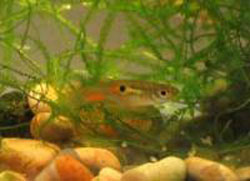Female guppies risk their lives to avoid too much male attention

Male and female guppies show a tendency to live in different types of habitats, known as sexual segregation.
Observing wild population of guppies in the rainforest of Trinidad, the researchers found that female guppies swim in habitats that contain few males – but many predators.
“Male guppies spend most of their time displaying to females. But if their courtship displays don’t impress the females, males will attempt to sneak mating with them when they aren’t looking,” says Croft.
Male guppies are brightly colored to attract female attention, while female guppies are a dull brown color. The researchers show that female guppies might use this color difference to their advantage, venturing into the deep water where predators lurk. The males’ bright coloring also attracts predators, making it too dangerous for them to follow.
“Understanding why and how [sexual segregation] occurs is essential if we are going to conserve and protect species and habitats,” explains Croft, who points out that fish are not the only species who display this social characteristic. “In many ecosystems, predators are the first to go extinct, and our work shows that this may have many, perhaps unexpected, effects. In this case, females may suffer more sexual harassment.”
Media Contact
More Information:
http://www.uchicago.eduAll latest news from the category: Life Sciences and Chemistry
Articles and reports from the Life Sciences and chemistry area deal with applied and basic research into modern biology, chemistry and human medicine.
Valuable information can be found on a range of life sciences fields including bacteriology, biochemistry, bionics, bioinformatics, biophysics, biotechnology, genetics, geobotany, human biology, marine biology, microbiology, molecular biology, cellular biology, zoology, bioinorganic chemistry, microchemistry and environmental chemistry.
Newest articles

Superradiant atoms could push the boundaries of how precisely time can be measured
Superradiant atoms can help us measure time more precisely than ever. In a new study, researchers from the University of Copenhagen present a new method for measuring the time interval,…

Ion thermoelectric conversion devices for near room temperature
The electrode sheet of the thermoelectric device consists of ionic hydrogel, which is sandwiched between the electrodes to form, and the Prussian blue on the electrode undergoes a redox reaction…

Zap Energy achieves 37-million-degree temperatures in a compact device
New publication reports record electron temperatures for a small-scale, sheared-flow-stabilized Z-pinch fusion device. In the nine decades since humans first produced fusion reactions, only a few fusion technologies have demonstrated…





















